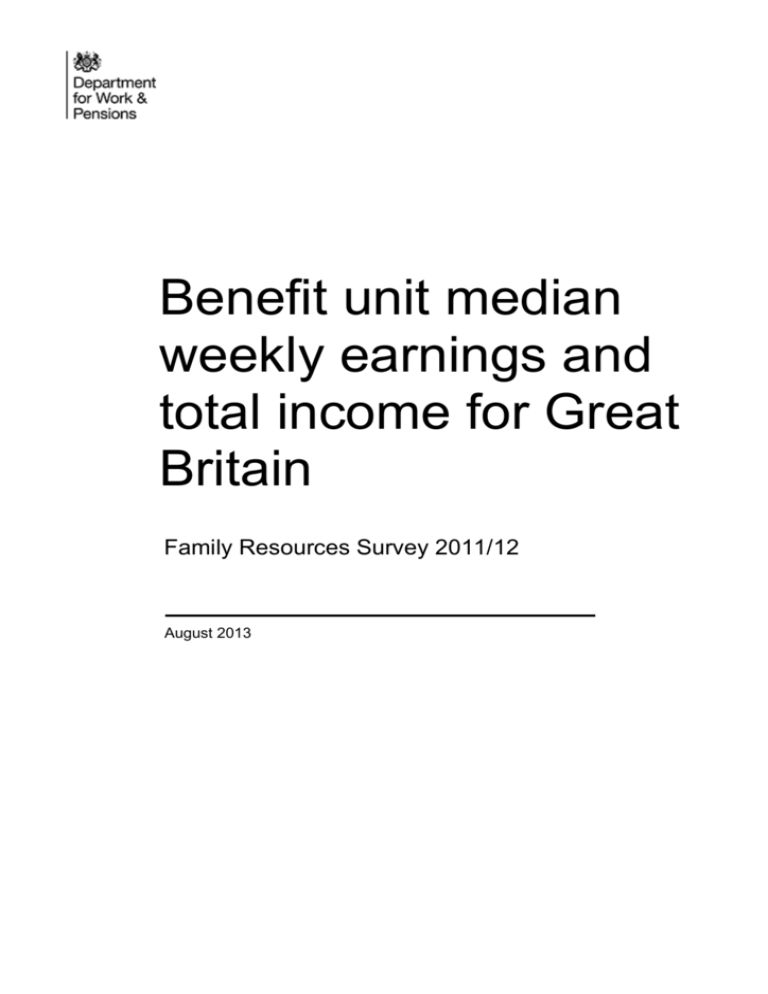Benefit unit median weekly earnings and total income for
advertisement

Benefit unit median weekly earnings and total income for Great Britain Family Resources Survey 2011/12 August 2013 Benefit unit median weekly earnings and total income for Great Britain, Family Resource Survey 2011/12 Contents Background ................................................................................................................ 3 Methodology ............................................................................................................... 5 Results ....................................................................................................................... 6 Contacts ..................................................................................................................... 8 Benefit unit median weekly earnings and total income for Great Britain, Family Resource Survey 2011/12 Background This analysis has been produced to provide an estimate of average weekly earnings using the latest published statistics, in response to a growing demand for estimates of average weekly earnings used for the Government’s considerations of the level of the benefit cap. 1 The Government has introduced a cap on the total amount of benefit that workingage households can receive so that, broadly, households on out-of-work benefits can no longer receive more in welfare payments than the average weekly earnings (after Income Tax and National Insurance Contributions) for working households. For the purposes of applying the benefit cap, the term household represents the basic family unit for the purposes of administering out-of-work benefits, which can be made up of a single adult or a couple, and any dependent children or qualifying young person for whom that adult or couple are responsible. These households are termed benefit units. Any individuals, such as adult children, grandparents etc. living in the same house, who may claim benefits independently, are not included in the same benefit cap calculation. The Family Resources Survey report and Households Below Average Income publications use a wider definition of household. 2 The cap has initially been set at £350 a week for a single adult who is not responsible for children, and £500 per week for a couple, with or without dependent children, or a lone parent who is responsible for a child. If affected, a household’s Housing Benefit entitlement will be reduced so that the total amount of benefit received is no longer higher than the cap level. The benefit cap was introduced from 15 April 2013 in Bromley, Croydon, Enfield and Haringey Local Authorities. National implementation of the cap began on 15 July 2013 and all households identified as being appropriate will be capped by the end of September 2013 The cap applies to the combined income from benefits including: 1 For a description of the methodology used to establish net median weekly earnings for the purposes of the benefit cap please refer to PQ 164331at: http://www.publications.parliament.uk/pa/cm201314/cmhansrd/cm130709/text/130709w0004.htm#130709111000 025 2 See page 256 at https://www.gov.uk/government/uploads/system/uploads/attachment_data/file/206778/full_hbai13.pdf 3 Benefit unit median weekly earnings and total income for Great Britain, Family Resource Survey 2011/12 the main out-of-work benefits (Jobseeker’s Allowance, Income Support, and Employment and Support Allowance except when the Support Component is in payment); Housing Benefit; Child Benefit; Child Tax Credit; and other benefits such as Carer’s Allowance. One-off payments and non-cash benefits, such as Free School Meals, are not included in the assessment of benefit income. Households which include someone who is entitled to Working Tax Credit (WTC) are excluded from the cap. There is also a grace period of 39 weeks during which time the cap will not apply to households where the claimant, or if applicable their partner, has worked for 50 weeks out of the 52 weeks preceding their last day of work. All households with someone, including a child, with a current award of Disability Living Allowance, Personal Independence Payment or Attendance Allowance, or receiving the support component of Employment and Support Allowance or Industrial Injuries Benefits (and those receiving War Disablement Pension and the equivalent payments from the Armed Forces Compensation Payments Scheme) are exempt from the benefit cap. This is in recognition of the extra costs disability can bring. The exemption is also extended to households which include a member who is in receipt of War Widow’s and War Widower’s Pension. This is in line with the Government’s commitment to offer special treatment to those who are serving or who have served in the Armed Forces, and to their dependants, in order to avoid disadvantage and recognise sacrifice for those seriously injured or killed. Help towards housings costs for those in Supported Exempt Accommodation is disregarded for the purposes of the benefit cap. However, some such households may still be subject to the cap if their benefits, excluding their housing support, exceed the cap levels set. Income from State Pension Credit or State Retirement Pension will not count towards the cap. 4 Benefit unit median weekly earnings and total income for Great Britain, Family Resource Survey 2011/12 Methodology These estimates use the latest, 2011/12, version of the DWP’s Family Resources Survey (FRS). 3 The FRS collects information on the income and circumstances of private households. For the 2011/12 survey around 20,000 households across the United Kingdom (UK) were interviewed between April 2011 and March 2012. The survey covers the UK, but this analysis is restricted to Great Britain. This analysis is at the benefit unit level: the definition of a benefit unit used in the FRS is a single adult or a married or cohabiting couple, plus any dependent children. 4 From January 2006 same-sex partners (civil partners and cohabitees) are also included in the same benefit unit. Analysis has been restricted to benefit units where the head of the benefit unit is aged below state pension age. Prior to 6th April 2010, women reached the State Pension age at 60. From 6th April 2010, the qualifying age for women has been gradually increasing. 5 The changes do not currently affect the State Pension age for men, currently 65. The head of the benefit unit is either the household reference person if the household reference person belongs to the benefit unit or, if not, it is the first person from the benefit unit in the order that they were named in the interview. The household reference person is the householder with the highest personal income from all sources. If there are two or more householders who have the same income, the household reference person is the eldest. The figures from the FRS are based on a sample of households and have been adjusted for non-response using multi-purpose grossing factors which align the FRS to regional populations by age and sex. Estimates are subject to both sampling error and remaining non-response error. 3 The latest FRS published in July 2013 can be found at: https://www.gov.uk/government/uploads/system/uploads/attachment_data/file/206887/frs_2011_12_report.pdf 4 A dependent child is aged under 16, or is an unmarried 16 to 19-year-old in full-time non-advanced education. 5 The rules are checked on the date of the interview to determine whether or not a person is of state pension age for each individual. 5 Benefit unit median weekly earnings and total income for Great Britain, Family Resource Survey 2011/12 Results The table below shows the median weekly earnings from employment/selfemployment and total income, both before, and after Income Tax and National Insurance Contributions (NICs) have been paid, by different family types, where the head of the benefit unit is aged below state pension age. The analysis has been confined to benefit units where net earnings from work are positive, and earnings from dependent children 6 have also been excluded from this analysis. The median is found by dividing the number of benefit units, when ranked by benefit unit earnings or income, into two equal sized groups and taking the middle weekly earnings or total income figure. Estimates used for the Government’s considerations of the level of the benefit cap, are based on net weekly earnings of couples, lone parents, and single-person benefit units with no children, which are represented by the “All” category in the table below. 6 Dependent children may have earnings from, for example, part-time jobs when aged 16-17. Non-dependent children are counted as a benefit unit in their own right in line with the definitions set out in the methodology section. 6 Benefit unit median weekly earnings and total income for Great Britain, Family Resource Survey 2011/12 Median weekly earnings and total income, where the head of the benefit unit is aged below state pension age within Great Britain, 2011/12. All Single no children Lone parents Couples no children Couples with children 420 270 200 590 600 (gross of income tax and NICs) 520 330 230 730 750 Total income (net of income tax and NICs) 490 280 400 640 670 Total income (gross of income tax and NICs) 600 340 420 790 820 Earnings (net of income tax and NICs) Earnings All figures are £ per week, and are rounded to the nearest £10 per week throughout. Figures are based on the benefit unit definition of households Figures for the “All” category refer to earnings or incomes of couples with or without children, lone parents, and single-person benefit units with no children. The analysis has been confined to benefit units where net earnings from work are positive, and earnings from dependent children have also been excluded from this analysis. 7 Benefit unit median weekly earnings and total income for Great Britain, Family Resource Survey 2011/12 Contacts Contact points for further information: Press enquiries should be directed to the Department for Work and Pensions press office: Media Enquiries: 0203 267 5129 Out of hours: 0203 267 5144 Website: https://www.gov.uk/ Follow us on Twitter: www.twitter.com/dwppressoffice Other enquiries about these statistics should be directed to: Joy Thompson (Joy.Thompson@dwp.gsi.gov.uk) Other National Statistics publications, and general information about the official statistics system of the UK, are available from www.statistics.gov.uk 8








